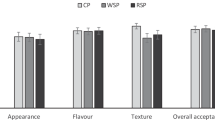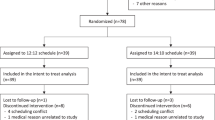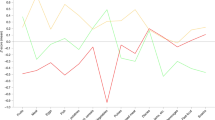Abstract
Television viewing (TVV) is considered a contributing factor to the development of childhood obesity yet it is unclear whether obesity results, in part, from increased energy intake during TVV. The objective of this study was to determine the effect of TVV on food intake (FI) of boys at a meal and its effect on caloric compensation at the test meal after a premeal glucose drink. On four separate mornings and in random order, boys received equally sweetened preloads containing Splenda sucralose or glucose [1.0 g/kg body weight (BW)] in 250 mL of water 2 h after a standard breakfast. Food intake from a pizza meal was measured 30 min later with or without TVV. Both preload treatment (p < 0.01) and TVV (p < 0.001) affected FI (kcal). TVV increased lunchtime FI by an average of 228 kcal. Glucose suppressed FI in the no TVV condition compared with control, but the effect was not statistically significant during TVV. Body composition and subjective appetite scores were positively associated with FI at the test lunch. In conclusion, TVV while eating a meal contributes to increased energy intake by delaying normal mealtime satiation and reducing satiety signals from previously consumed foods.
Similar content being viewed by others
Log in or create a free account to read this content
Gain free access to this article, as well as selected content from this journal and more on nature.com
or
Abbreviations
- BW:
-
body weight
- FI:
-
food intake
- FFM:
-
fat free mass
- FM:
-
fat mass
- PFC:
-
prospective food consumption
- VAS:
-
visual analogue scale
References
Dietz WH Jr, Gortmaker SL 1985 Do we fatten our children at the television set? Obesity and television viewing in children and adolescents. Pediatrics 75: 807–812
Robinson TN 1999 Reducing children's television viewing to prevent obesity: a randomized controlled trial. JAMA 282: 1561–1567
Canada S 2006 Television Viewing: Data Tables. Statistics Canada, Ottawa, Canada, Catalogue no. 87F0006XIE
Nielsen Media Research 2000 2000 report on television: the first 50 years. AC Nielsen Co, New York
Matheson DM, Killen JD, Wang Y, Varady A, Robinson TN 2004 Children's food consumption during television viewing. Am J Clin Nutr 79: 1088–1094
Jeffery RW, French SA 1998 Epidemic obesity in the United States: are fast foods and television viewing contributing?. Am J Public Health 88: 277–280
Robinson TN 2001 Television viewing and childhood obesity. Pediatr Clin North Am 48: 1017–1025
Coon KA, Goldberg J, Rogers BL, Tucker KL 2001 Relationships between use of television during meals and children's food consumption patterns. Pediatrics 107: E7
Stroebele N, de Castro JM 2004 Television viewing is associated with an increase in meal frequency in humans. Appetite 42: 111–113
Van den Bulck J, Van Mierlo J 2004 Energy intake associated with television viewing in adolescents, a cross sectional study. Appetite 43: 181–184
Francis LA, Birch LL 2006 Does eating during television viewing affect preschool children's intake?. J Am Diet Assoc 106: 598–600
Anderson GH, Catherine NL, Woodend DM, Wolever TM 2002 Inverse association between the effect of carbohydrates on blood glucose and subsequent short-term food intake in young men. Am J Clin Nutr 76: 1023–1030
Anderson GH, Tecimer SN, Shah D, Zafar TA 2004 Protein source, quantity, and time of consumption determine the effect of proteins on short-term food intake in young men. J Nutr 134: 3011–3015
Birch LL, McPhee L, Sullivan S 1989 Children's food intake following drinks sweetened with sucrose or aspartame, time course effects. Physiol Behav 45: 387–395
Birch LL, McPhee L, Steinberg L, Sullivan S 1990 Conditioned flavor preferences in young children. Physiol Behav 47: 501–505
Johnson SL, Birch LL 1994 Parents' and children's adiposity and eating style. Pediatrics 94: 653–661
Black RM, Anderson GH 1994 Sweeteners, food intake and selection. Appetite and Body Weight Regulation: Sugar, Fat, and Macronutrient Substitutes. CRC Press, Boca Raton, FL, pp 125–136
Dietitians of Canada, Canadian Paediatric Society, College of Family Physicians of Canada, Community Health Nurses Association of Canada 2004 The use of growth charts for assessing and monitoring growth in Canadian infants and children. Can J Diet Pract Res 65: 22–32
Ogden CL, Kuczmarski RJ, Flegal KM, Mei Z, Guo S, Wei R, Grummer-Strawn LM, Curtin LR, Roche AF, Johnson CL 2002 Centers for Disease Control and Prevention 2000 growth charts for the United States: improvements to the 1977 National Center for Health Statistics version. Pediatrics 109: 45–60
Woodend DM, Anderson GH 2001 Effect of sucrose and safflower oil preloads on short term appetite and food intake of young men. Appetite 37: 185–195
Anderson GH, Woodend D 2003 Effect of glycemic carbohydrates on short-term satiety and food intake. Nutr Rev 61: S17–S26
Duffy VB, Anderson GH 1998 Position of the American Dietetic Association: use of nutritive and nonnutritive sweeteners. J Am Diet Assoc 98: 580–587
Anderson GH, Saravis S, Schacher R, Zlotkin S, Leiter L 1989 Aspartame: effect on lunch-time food intake, appetite and hedonic response in children. Appetite 13: 93–103
Stubbs RJ, Hughes DA, Johnstone AM, Rowley E, Reid C, Elia M, Stratton R, Delargy H, King N, Blundell JE 2000 The use of visual analogue scales to assess motivation to eat in human subjects: a review of their reliability and validity with an evaluation of new hand-held computerized systems for temporal tracking of appetite ratings. Br J Nutr 84: 405–415
Halford JC, Gillespie J, Brown V, Pontin EE, Dovey TM 2004 Effect of television advertisements for foods on food consumption in children. Appetite 42: 221–225
Heymsfield SB, Williams PJ 1988 Nutritional assessment by clinical and biochemical methods. In: Shils M, Young V (eds) Modern Nutrition in Health and Disease. Lea & Febiger, Philadelphia, pp 817–860
Archibald EH, Harrison JE, Pencharz PB 1983 Effect of a weight-reducing high-protein diet on the body composition of obese adolescents. Am J Dis Child 137: 658–662
Brook CG 1971 Determination of body composition of children from skinfold measurements. Arch Dis Child 46: 182–184
Birch LL, Deysher M 1985 Conditioned and unconditioned caloric compensation: evidence of self-regulation of food intake by young children. Learn Motiv 16: 341–355
Gerstein DE, Woodward-Lopez G, Evans AE, Kelsey K, Drewnowski A 2004 Clarifying concepts about macronutrients' effects on satiation and satiety. J Am Diet Assoc 104: 1151–1153
Bellisle F, Dalix AM 2001 Cognitive restraint can be offset by distraction, leading to increased meal intake in women. Am J Clin Nutr 74: 197–200
Anderson GH 2006 Sugars-containing beverages and post-prandial satiety and food intake. Int J Obes (Lond) 30: S52–S59
Birch LL, Deysher M 1986 Caloric compensation and sensory specific satiety: evidence of self-regulation of food intake by young children. Appetite 7: 323–331
Rogers PJ, Carlyle JA, Hill AJ, Blundell JE 1988 Uncoupling sweet taste and calories: comparison of the effects of glucose and three intense sweeteners on hunger and food intake. Physiol Behav 43: 547–552
Drapeau V, Blundell J, Therrien F, Lawton C, Richard D, Tremblay A 2005 Appetite sensations as a marker of overall intake. Br J Nutr 93: 273–280
Burton-Freeman B, Davis PA, Schneeman BO 2004 Interaction of fat availability and sex on postprandial satiety and cholecystokinin after mixed-food meals. Am J Clin Nutr 80: 1207–1214
Acknowledgements
The authors thank Benson Fong and Thomas Dobosz for help with the project.
Author information
Authors and Affiliations
Corresponding author
Additional information
Supported by an operating grant from the Canadian Institute of Health Research (grant MOP-64430) and a scholarship to N.B. from the Danone Institute of Canada.
Rights and permissions
About this article
Cite this article
Bellissimo, N., Pencharz, P., Thomas, S. et al. Effect of Television Viewing at Mealtime on Food Intake After a Glucose Preload in Boys. Pediatr Res 61, 745–749 (2007). https://doi.org/10.1203/pdr.0b013e3180536591
Received:
Accepted:
Issue date:
DOI: https://doi.org/10.1203/pdr.0b013e3180536591
This article is cited by
-
Twelve-month effectiveness of telephone and SMS support to mothers with children aged 2 years in reducing children’s BMI: a randomized controlled trial
International Journal of Obesity (2023)
-
Screen time duration and timing: effects on obesity, physical activity, dry eyes, and learning ability in elementary school children
BMC Public Health (2021)
-
Relationship between screen time and nutrient intake in Japanese children and adolescents: a cross-sectional observational study
Environmental Health and Preventive Medicine (2018)
-
Health outcomes of non-nutritive sweeteners: analysis of the research landscape
Nutrition Journal (2017)
-
The relationship between hours of sleep, screen time and frequency of food and drink consumption in Spain in the 2011 and 2013 ALADINO: a cross-sectional study
BMC Public Health (2017)



